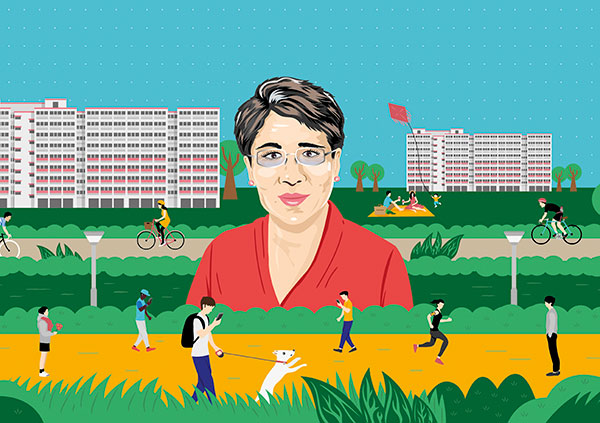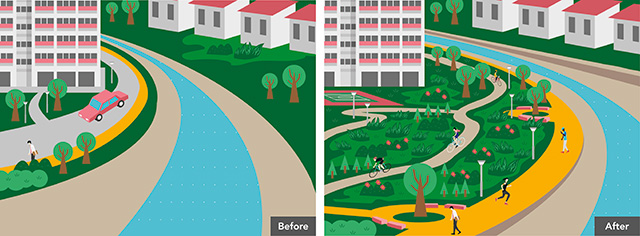Outsized Ideas For More Green Spaces

For the past 25 years, Ms Tay Bee Choo, Deputy Director of Landscape Implementation at the Housing & Development Board (HDB), has been devising creative ways to bring beautiful green spaces to public housing estates.
Years ago, before joining the Public Service, she often drove her friends back to their HDB flats in Jurong, Yishun and Ang Mo Kio after evening games of squash.
“I was struck by how similar all the neighbourhoods looked,” recalls the 62-year-old, who is one of Singapore’s first landscape architects.
“Back then, it was just simple turf, trees and footpaths. I felt that we could do things differently: HDB residents should enjoy something pleasant to the eye, not just carpark lots and rain trees dotting their neighbourhoods.
“I felt we could create the same kind of open spaces and gardens that were available to condominium residents then,” adds Ms Tay. So in 1992, she left her comfortable private-sector job to join the HDB.
Sharing Expertise
Ms Tay has worked on countless housing estates, enhancing their surrounding biodiversity so residents could feel closer to nature.
In 2007 came a challenge she now considers a major achievement: creating a rain-garden, Singapore’s first, along the Pelton Canal in MacPherson as part of the Balam estate project.
One of the earliest multi-agency schemes, involving the HDB, the national water agency PUB and National Parks Board (NParks), and led by the Land Transport Authority (LTA), the Balam estate project served to reinstate the areas around the Pelton Canal, which had been diverted for the building of the Kallang-Paya Lebar Expressway.
When the LTA first consulted Ms Tay on the trees to plant, she offered to update their old landscape plans to 2007 standards. Together with NParks, she drew up a new plan to show “how to put everything back... without any of our agencies spending an extra dollar,” she shared at a Centre for Liveable Cities lecture.
For the agencies, the reinstatement was an opportunity to incorporate a more sustainable landscape in the area, as well as a recreational green space.

PUB commissioned the eco-friendly rain-garden there. The 0.6ha patch of green acts as a natural filter for rainwater, trapping debris before releasing the dirt-free water into the canal, which flows into a reservoir. Such cleaner water is cheaper to treat. The ground was graded without compacting the earth so that water runoff can percolate deep into the lawn, removing the need for concrete drains.
Exercise areas, colour-coded multi-purpose seats and trees to provide shade were added to create conducive spaces for residents to meet and bond.
To enhance safety, the former 6m-wide park connector was split into designated paths: one for walkers and joggers by the waterway, and a cycling path that meanders into the HDB precinct gardens.
“The strategy was to integrate the park connector and HDB spaces as one continuous area to enhance connectivity,” Ms Tay tells Challenge.
By 2008, the project was completed. The park connector and gardens have since been a hit with residents, who use them as social gathering points.
Wheeling and Dealing
Traditionally, public landscape spaces are managed under the jurisdiction of various agencies that focus on the areas directly under their charge.
But the town council contractors may not be as well trained as NParks contractors at maintaining trees, Ms Tay points out. Another difficulty comes from handing duties over to the town councils, “because it might be extra work for them”, says Ms Tay.
Negotiation and compromise proved essential to making things work.
For instance, in the upkeep of the greenery, the load was carefully managed. “What I did was to talk to NParks to get them to maintain the trees that were planted within HDB estates that provide shade for the park connector,” Ms Tay recalls. “Then I went to the Marine Parade Town Council and explained to them what NParks was doing, so I convinced them to take care of the shrubs and the maintenance for PUB’s rain garden.”

With the work shared and everyone clear about their roles, “it is a win-win situation for everybody.”
And as she has built good relationships with officers in partner agencies over the years, “selling my ideas to the various parties was not difficult — it’s just about working on the details.”
For the Balam estate project, she had also wanted black railings to modernise the green railings typical “of the ’70s”. However, the National Environment Agency (NEA) was bound by a five-year contract for railing maintenance that only allowed for green paint.
“So I used a durable matte black railing that will only need repainting after the NEA’s current contract ends, and it can include black in its new contract,” she reveals.
While she is ready to think out of the box to get her ideas implemented, Ms Tay is also pragmatic.
“Innovating is a challenge, but always ask what the other party is doing so you can come up with a proposal,” she says. “Whatever we learn on these projects will be used in the newer neighbourhoods.”
Indeed, the Balam rain-garden, which she describes as “ahead of its time”, has since been replicated in Punggol and will be implemented in the Tengah estate.
“Landscape architects are the stewards of the land,” Ms Tay says. “Yes, it is tiring work and can also go [beyond] my normal duty. But to me, it is a personal challenge... The reward is seeing the residents happy.”
- POSTED ON
Mar 15, 2018
- TEXT BY
Zul Othman
- ILLUSTRATION BY
Mushroomhead









